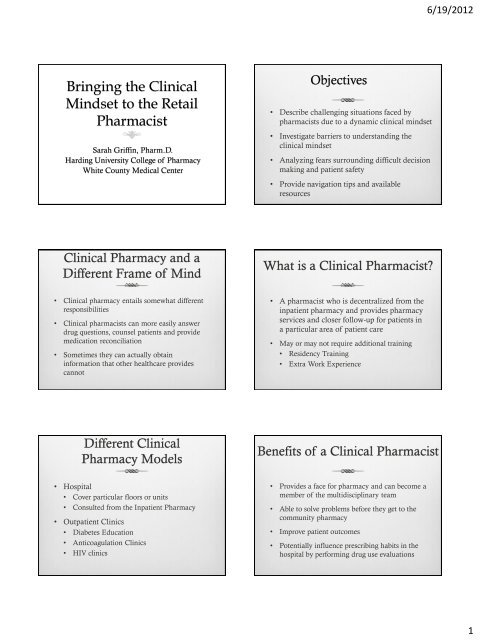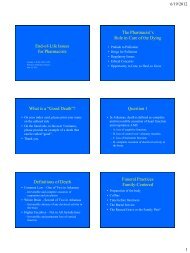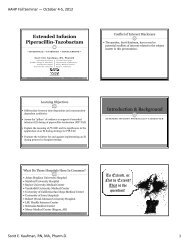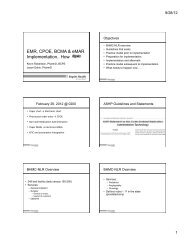Sarah Griffin, Pharm.D.
Sarah Griffin, Pharm.D.
Sarah Griffin, Pharm.D.
You also want an ePaper? Increase the reach of your titles
YUMPU automatically turns print PDFs into web optimized ePapers that Google loves.
6/19/2012Bringing the ClinicalMindset to the Retail<strong>Pharm</strong>acist<strong>Sarah</strong> <strong>Griffin</strong>, <strong>Pharm</strong>.D.Harding University College of <strong>Pharm</strong>acyWhite County Medical CenterObjectives• Describe challenging situations faced bypharmacists due to a dynamic clinical mindset• Investigate barriers to understanding theclinical mindset• Analyzing fears surrounding difficult decisionmaking and patient safety• Provide navigation tips and availableresourcesClinical <strong>Pharm</strong>acy and aDifferent Frame of MindWhat is a Clinical <strong>Pharm</strong>acist?• Clinical pharmacy entails somewhat differentresponsibilities• Clinical pharmacists can more easily answerdrug questions, counsel patients and providemedication reconciliation• Sometimes they can actually obtaininformation that other healthcare providescannot• A pharmacist who is decentralized from theinpatient pharmacy and provides pharmacyservices and closer follow-up for patients ina particular area of patient care• May or may not require additional training• Residency Training• Extra Work ExperienceDifferent Clinical<strong>Pharm</strong>acy ModelsBenefits of a Clinical <strong>Pharm</strong>acist• Hospital• Cover particular floors or units• Consulted from the Inpatient <strong>Pharm</strong>acy• Outpatient Clinics• Diabetes Education• Anticoagulation Clinics• HIV clinics• Provides a face for pharmacy and can become amember of the multidisciplinary team• Able to solve problems before they get to thecommunity pharmacy• Improve patient outcomes• Potentially influence prescribing habits in thehospital by performing drug use evaluations1
6/19/2012Clinical <strong>Pharm</strong>acistChanging the Profession• Participates in the decision making process ofwhat drug(s) should be chosen• Manage patient’s medications in a clinic setting• This responsibility brings with it challenges• These challenges may vary based on the locationand dynamics of a particular hospital or clinic• Some challenges are similar across the country• Currently moving toward a more integratedpharmacy model• Change has been in the works since 1985• Optimizing pharmacists in the role ofpatient care• Mostly been implemented in the hospitalsetting• Extending to the ambulatory care settingDefinitionMore than just “Thinking”• Clinical Mindset “Thinking Clinically”• Knowledge, Perspective and Resources• Keeping abreast of the efficacy and safetyinformation for drugs• Having a bigger impact upon patient care• There is a need to think clinically• “Thinking Clinically” is more than just brushingup on clinical knowledge• To think is to analyze new ideas, to change yourperspective is to develop a new mindset• Having a Clinical Mindset refers to changing yourperspective toward incorporating resources of aclinical modelHow is the Clinical MindsetDifferent?• Often clinical pharmacists have a morecomplete picture of the patient being treated• More opportunities for educating nursesand physicians about the role ofpharmacists• In a better position to advocate formedication safety and complianceDynamic Clinical Mindset• Mindset shaped by multiple healthcareprofessionals• Constantly being bombarded with new conceptsin medicine• Appropriate medical treatment may be vieweddifferently by various health professionalsdepending on their specialty• This difference of training can lead to differingopinions about patient care and lead2
6/19/2012Challenge Extends Beyondthe HospitalClinical <strong>Pharm</strong>acistResponsibilities• Patients are often switched to “equivalent” drugsduring their hospital stay• The medication may or may not be needed upondischarge• New drugs prescribed upon discharge based on theformulary may not be covered by the patient’sinsurance• Physician accustomed to the formulary and maynot have good knowledge of insurance issues, etc.• Work with a social worker to determine need forextra assistance and to ensure that the patient isable get their medications• This is where clinical meets community• There can be a disconnect at this point which leadsto frustration for the community pharmacist• Clinical pharmacists can play a big role in bridgingthis gap through educationBarriers to Solving theseChallenges• Differences in goals and responsibilities• Misperceptions of pharmacists goals andresponsibilities (community vs. clinical)• Perception that we, as pharmacists, are notintegrated• Resistance to change from the Status Quo• “This is how we have always done it”Understanding Our Role• “Dr. said it, therefore it must be correct?”• <strong>Pharm</strong>acists are well educated and have agreat responsibility in patient safety• <strong>Pharm</strong>acists are patient advocates• Educate all patients and health professionalsTools We NeedGet Involved with Patient Care• How can we overcome these barriers?• Communication is the Key• Education is just as important• Patience is a must• We should have the courage to stand togetherand take on new challenges• Optimizing pharmacist’s ability to bridge thegap in healthcare• You may be the only health professional someof your patients see for an extended period oftime• Use MTM services to keep more than just arecord of a patient’s medication list5
6/19/2012IntegrationHelp Each Other Find Answers• To work together we must understand andrespect what all parties bring to the table• “Never judge someone until you havewalked a mile in their shoes”• We start to see some of the perspective ofother health professionals and they begin tounderstand and respect pharmacists• Providing Medication Therapy Managementputs you more in tune with your patients andexpands your ability to assess and becomemore clinically minded• Sometimes their may be questions that aredifficult to answer• Other questions can be explained with a littlehelp from a friendA Better Model?Fears arising from newopportunities• Collaborative Practice Agreements• More freedom for the pharmacist• Alternative method: working with a clinicalpharmacist• Investigate clinical opportunities when theycome available and see what works for you• Decisions may arise that require you tomake a clinical decision as a communitypharmacist• May not be able to contact the patientsprovider• This may lead to fear and apprehension• Deter you from offering more servicesKnow Your ResourcesIn this Together• Publications• Guidelines• Access to resources as preceptor• Network in state and out of state• Take advantage of technology• Know the state laws• As healthcare becomes more integrated, we aspharmacist need to become more integrated• In today’s society we can never assumesomeone else is taking care of the problem• Empower each other and your patientsthrough education6
6/19/2012Resources• Page II RL, Hume AL, Trujillo JM. Interprofessional Education: Principlesand Application. A Framework for Clinical <strong>Pharm</strong>acy. <strong>Pharm</strong>acotherapy2009;29(3):145e-164e.• Kaboli PJ, Hoth AB, McClimon BJ. Clinical <strong>Pharm</strong>acists and InpatientMedical Care: A Systematic Review. Arch Intern Med 2006;166(9):955-964.• Manasse, Jr. Henri R. Health-system pharmacy’s imperative for practice modelchange. Am J Health-Syst <strong>Pharm</strong> 2012;69:972-8.• Dobesh PP, Bosso J, Wortman S. Critical Pathways: The Role of <strong>Pharm</strong>acyToday and Tomorrow. <strong>Pharm</strong>acotherapy 2006;26(9):1358-1368.• Burke JM, Miller WA, Spencer AP. Clinical <strong>Pharm</strong>acy Competencies.<strong>Pharm</strong>acotherapy 2008;28(6):806-8157








